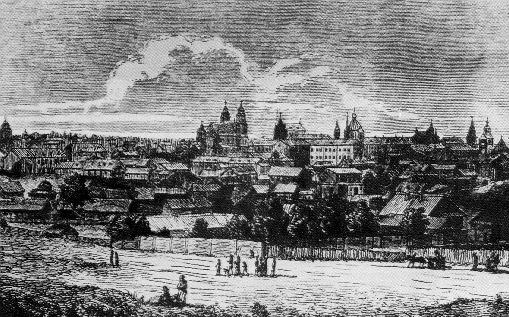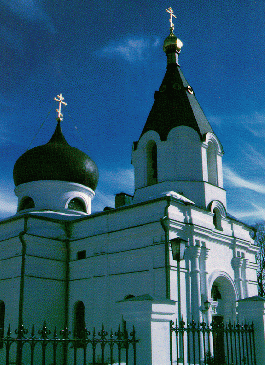
The Russian Governors' first steps were to restrict the Belarusian Greek-Catholic Church; the Basilian Convents in the Upper Town and in Trinity suburb were closed in 1795, and the Holy Ghost Church handed over to the Russian Orthodox hierarchy, who in 1796 renamed it after the apostles SS. Peter and Paul. The former Belarusian Orthodox Church with this name was reconsecrated to St. Catherine, thus commemorating the parthners of the two sovereigns who had established Russian rule over the city. Plans were drawn up for impoving the city amenities; public gardens were laid out by the river Svislacz, which were named the Governor's Gardens, and the architect Todar Kramer was commissioned to remodel the City Guildhall, the Vice-governor's residence(1800), the Basilian monastery, now a school for children of the gentry(1799), the Merchants' Exchange(1800), the Jesuit college and the Holy Trinity convent in the Trinity suburb(1799) and other buildings. These reconstructions were done to neutral neo-classical designs of West European municipial arcitecture, which left little room for national particularism.
Minsk in the 19th century

In 1812 the French Emperor Napoleon crossed the Nioman river, making the purpose of his campaign against the Tsar plain to his generals. Irritated, after a meeting with Alexander's envoy, General Balachov, by the pretensions of successive Russian Tsars to make themselves the arbiters of the European politics, he explained to his General Berthier, Caulaincourt and Duroc: "Alexander takes me for a fool, Does he think that I have come to Vilnia to negotiate trade agreements? I have to finish off, once and for all, this colossus of the barbarians of the North. The sword is drawn. They must be driven back to their ice-fields so that for twenty-five years they do not come meddling in the affairs of civilized Europe... He[Alexander] is afraid and wants a settlement, but I only sign a peace treaty in Moscow... If he wants victories, let him beat the Persians, but let him note meddle with Europe. Civilization repudiates these Norsemen. Europe should put its house in order without them." The composition of his confederate army -- French, Poles, Italians, Germans, Dutchmen, Portuguese and Austrians -- gave some weight to his claim to be acting for Europe. Napoleon leaving Marshal Oudinot to hold Polacak, and Marshal Davout to occupy Minsk drove on to Viciebsk. Only 180,000 men set off from Smalensk for Moscow: the rest were protecting the Grande Armee's flanks or were on garrison duty. Most of whatever material destruction took place during the campaign was caused by the brutal but very effective Russian tactics of "scorched earth" -- burning cities(among them Mahiliou and Smalensk), villages and crops to prevent them from being taken by the enemies of the Orthodox Tsar.
In Minsk Devout received strong local support and attended a Te Deum celebrated by the Bishop Dederko to mark the liberation of the city from Russian rule. A popular move was a decree confiscating the harvests of the fleeing Russian nobility, and dividing them equally between the Army, the Civil administration, and the peasants. Implementing Napoleon's plan to restore the Grand Duchy of Lithuania and Belarus as two separate states, with their capitals in Vilnia and Mahiliou, Minsk was made the Prefecture of a revolutionary department, and numerous Belarusian volunteers formed units in the Grande Armee. During Napoleon's retreat from Moscow these volunteers fought with great valour, defending the bridges and covering the French crossings of the Biarazina. Allowing for heavy losses sustained at Borodino and other engagements at Krasnaje, together with subsequent desertions of disaffected Germans and other allies, the arrival at the bridges of 70,000 men in combat order was hardly that of a defeated army. In the words of an old French soldier of the Imperial Guards who made it back to Vilnia: "We gave them a good trunching at every turn, just the same. Those "Russkis" are only a bunch of schoolboys." On the return of Kutuzov to Minsk in late November there were few reprisals, with the exception of the Bishop Dederka who was suspended, and a general amnesty was subsequently proclaimed.
Russian rule thereafter remained relatively mild, save for the suppression of Greek-Catholic church, until uprisings of 1831 and 1863. Then russification began in earnest with Russian style churches being built in prominent positions, or existing churches being revamped into sometimes grotesque pseudo-Russian style(SS. Peter and Paul prior to 1979). The National Uniate church was suppressed in 1839, occassionally at sword point, with many recalcicrant priests being imprisoned or deported for up to thirty years. Many of the Latin clergy were expelled; the Bernhadine convent and Church were given over to Russian Orthodox monks. The Dominican Church became an army warehouse and the Bernhadine Church of St. Joseph a city archive. Streets were given different names in Russian to efface the memory of the old order: Franciskankaja became Gubernatorskaja, Dominikanskaja was renamed Petrapaulauskaja, Bernadzinski zavulak -- Monastyrski, Felicijanskaja -- Bogodelnaja, Mastovskaja -- Paliciejskaja and so on. An ukaz of the Tsar Nikolas I abolished the very use of names Belarus and Belarusian. The consequences of Kastus Kalinouski' uprising were important and far reaching for the city of Minsk and the surrounding areas. Many thousands of their inhabitants were deported to Siberia, or imprisoned -- among them the poet Vincent Dunin-Marcinkievicz, -- in the Pilszczalauski Fortress, erected in 1825, almost in anticipation of future trouble.
The Church of Mary Magdalene
 Yet
apart from these upheavals, a long period of peace brought with it material prosperity.
Industry and the arts flourished though occational fires and epidemics continued to plague
the city. There were two particularly virulent outbreaks of typhus in 1848 and 1853. The
Tsars showed little interest in Minsk and seldom visited it, except on tours of inspection
of the Imperial Army headquarters in Mahiliou. Alexander I came in 1819 to address the
nobility, and Alexander II visited the city in 1859. Permission to built Catholic churches
was generally limited to cemetery chapels, though exuberant Russian churches and shrines
such as the new Cathedral, the Church of the Protection and the Holy Cross, St.
Mary Magdalene, St. Alexander Nevski, the Church of the Trasfiguration, Our
Lady of Kazan and others mushroomed across the city. The old coat-of-arms granted by
Zhyhimunt IV charged with the image of the Teotokos, which in 1796 had been augmented with
the Russian double-headed eagle, was untimately replaced in 1878 by a field or,
"three wavy bars azure". Perhaps most relevant to the quality of life and the
inhabitants was the installation of the municipal water system(1874), a telephone
service(1890), two-horse drawn tram-lines(1892) and current electricity(1895).
Yet
apart from these upheavals, a long period of peace brought with it material prosperity.
Industry and the arts flourished though occational fires and epidemics continued to plague
the city. There were two particularly virulent outbreaks of typhus in 1848 and 1853. The
Tsars showed little interest in Minsk and seldom visited it, except on tours of inspection
of the Imperial Army headquarters in Mahiliou. Alexander I came in 1819 to address the
nobility, and Alexander II visited the city in 1859. Permission to built Catholic churches
was generally limited to cemetery chapels, though exuberant Russian churches and shrines
such as the new Cathedral, the Church of the Protection and the Holy Cross, St.
Mary Magdalene, St. Alexander Nevski, the Church of the Trasfiguration, Our
Lady of Kazan and others mushroomed across the city. The old coat-of-arms granted by
Zhyhimunt IV charged with the image of the Teotokos, which in 1796 had been augmented with
the Russian double-headed eagle, was untimately replaced in 1878 by a field or,
"three wavy bars azure". Perhaps most relevant to the quality of life and the
inhabitants was the installation of the municipal water system(1874), a telephone
service(1890), two-horse drawn tram-lines(1892) and current electricity(1895).
However, all these to suppress the language, the national symbolica, and to adulterate the visible signs of Belarusian individuality, finally brought a growing number of Belarusians to the realization that they were indeed a different nation. Ethnographical traditions engendered national pride, even as the nationalist poets Maxim Bahdanovicz and Zmitrok Biadulia were born, one of an eminent Minsk enthnogpapher, the other of a traditionally minded Hassidic Jew from the Lahojsk hills. The unique flavor of Belarusian life was captured in works of one of Minsk's greatest residents, who now lies buried here, -- Jakub Kolas. During this period Minsk acquired its National Theater(1890), its first School of Art founded by Ja. Kruher(1906), the beginnings of its "Academy of Sciences" at the Belarusian Chata(1913) and proposals were also made in 1913 for the establishment of the National University in Minsk. Renewed stirrings of national protest came with anti-tsarist riots in 1905. There were strikes and demostrations in Minsk, and the students of the Orthodox seminary set fire to their college; as a result societies and clubs were dissolved, students expelled, and the poets Jakub Kolas, Kastus Kalaniec, and Ales Harun, among many others, were imprisoned for their clandestine activities.